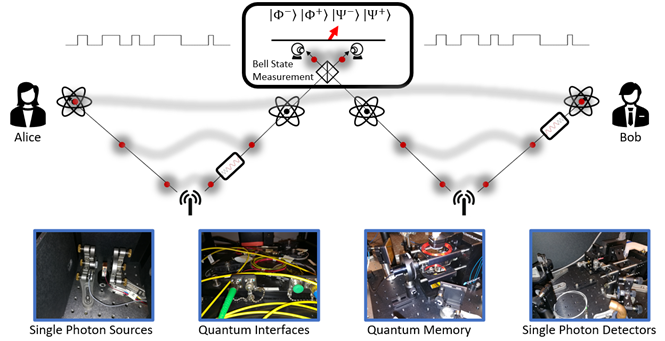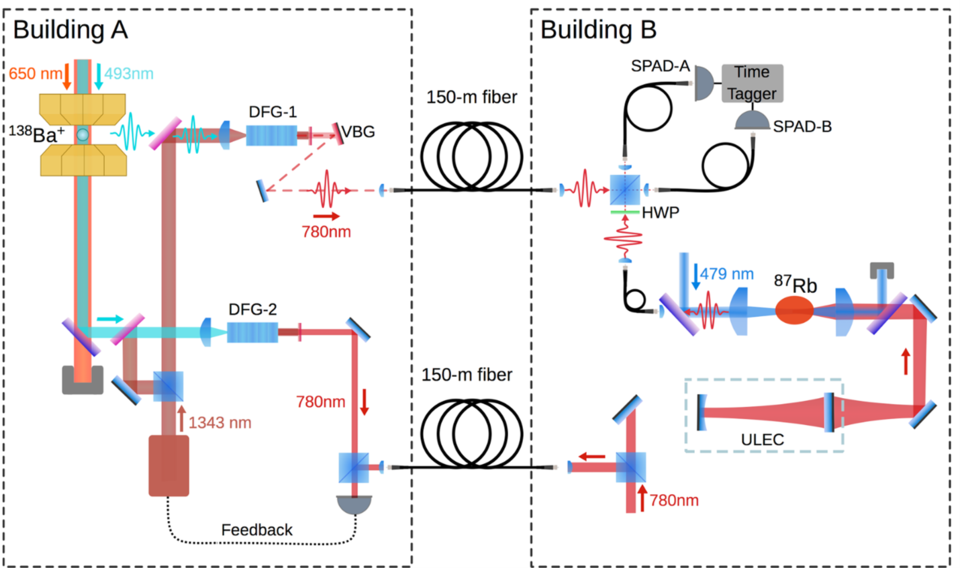Connecting Quantum Network Nodes
Optically connecting remote nodes with quantum functionality paves the path toward more ambitious regional, national, and, ultimately, global quantum networks. To connect two quantum nodes, different quantum devices such as transducers, quantum light sources, and detectors are operated simultaneously and must be compatible. Such point-to-point links are a useful tool to identify parameter thresholds for the components and to test communication protocols which can preserve quantum information in the presence of noise and loss.
Optical Networking of Microwave Entanglement Nodes with Transduction Devices
Creating remote microwave entanglement for the networking of superconducting quantum computers is the main goal of this project. We have designed and are constructing an optical testbed containing a source of two-mode squeezed states and microwave-to-optical transducers. The squeezed optical states provide the continuous variable quantum resource that is delivered to the network nodes by optical fibers to establish remote entanglement. At the network nodes, the optical states are converted to the microwave domain with doubly-parametric, membrane-coupled, resonator devices developed at NIST/JILA with the world’s best available transduction performance.

PI contact: Tasshi Dennis
Notable Publications:
A. Kyle, C. Rau, A. Kwiatkowski, E. Shojaee, J. Teufel, K. Lehnert, and T. Dennis, Entanglement Thresholds of Double-Parametric Quantum Transducers, Physical Review Applied, 17, 044057 (2022), https://doi.org/10.1103/PhysRevApplied.17.044057
Technology Readiness Level: 3
Connecting Quantum Repeater Nodes via telecom light
Our goal is to connect neutral atom-based repeaters via telecom photons. To reach this goal, the Quantum Communication and Networks Project develops quantum devices and studies them for use in quantum communications and networking applications. Because photon states that are required to interface with the memory are unfit for long-distance transmission through fiber, a set of quantum auxiliary devices is required. Thus, we build and study quantum devices, such as entangled-photon sources, single-photon detectors, optical quantum memory, and quantum transduction/interfaces – all essential components of a telecom-connected quantum repeater.

PI contacts: Oliver Slattery, Lijun Ma, Xiao Tang, Thomas Gerrits
Notable Publications:
O. Slattery, L. Ma, and X. Tang, A cascaded interface to connect quantum memory, quantum computing and quantum transmission frequencies, Frontiers in Optics Laser Science, Washington, DC (2019)
Technology Readiness Level: 2-3
Hybrid system two-photon interference
Many protocols for generating remote entanglement use interference between photons produced by the different network nodes, which requires frequency conversion to match the photons from the disparate sources. In collaboration with researchers at the Army Research Lab, we realize two-photon interference between photons generated from a rubidium atomic ensemble and a trapped barium ion after closely matching their center frequencies via difference frequency generation. The infrastructure developed provides the basis for future entanglement distribution among heterogeneous nodes.

PI contact: Trey Porto
Notable Publications:
A. Craddock, J. Hannegan, D. Ornelas-Huerta, J. Siverns, A. Hachtel, E. Goldschmidt, J. Porto, Q. Quraishi, and S. Rolston, Quantum interference between photons from an atomic ensemble and a remote atomic ion, Physical Review Letters, 123, 213601 (2019), https://doi.org/10.1103/PhysRevLett.123.213601
Technology Readiness Level: 4
Contacts
-
(301) 975-5887
-
(301) 975-4281
-
(301) 975-8473

